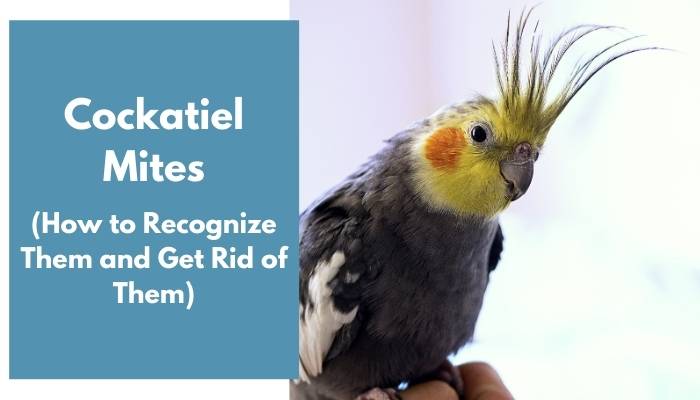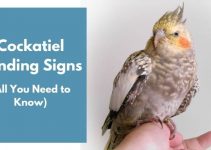Cockatiel mites (also known as feather mites) are parasites that can live on your pet’s feathers. These things are so small that it’s quite impossible to notice with a glance. The thing about these mites is that they can harm your cockatiel if you don’t deal with them as soon as possible.
Feather mites aren’t something noticeable due to their size. Yet, they can do some damage and harm if left unchecked.
For this reason, you need to learn and understand how to deal with mites to take care of your cockatiel properly.
Without further ado, let’s get into it!
Contents
- 1 Do cockatiels get mites?
- 2 How do you know if your cockatiel has mites?
- 2.1 Restlessness during the day
- 2.2 Preening quite aggressively
- 2.3 Crusty looking areas in eyes and beak
- 2.4 Scaly and irritated skin
- 2.5 Coughing, sneezing, open-mouth breathing, difficulty breathing
- 2.6 Feather damage and loss
- 2.7 Heads and legs swarmed by mites at night.
- 2.8 Clusters of small red spots on the cage
- 3 How do you get rid of mites on cockatiels?
- 4 How do birds get mites?
- 5 How to prevent cockatiels from getting mites?
- 6 Summary
- 7 Resources
Do cockatiels get mites?
The short answer is yes. Cockatiels do get mites, and it’s something every pet bird owner dreads.
The thing about mites is that they are so small, and they stick into the feathers. Thus, they are famous as feather mites.
These parasites can affect your pet by living in its feathers, sucking and biting from such.
What makes feather mites problematic is that they are hard to spot. Thus, you won’t know your pet has some in just a glance.
If you use a magnifying tool, you may notice such mites, but only as small dark spots lying in your pet’s feathers.
Now, while it may seem a bit difficult to notice feather mites in your pet, it will help if you know how to detect them.
You Might Also Read:
How do you know if your cockatiel has mites?
The best way to know if your cockatiel has mites is to check the symptoms.
Although the mites per se aren’t easy to watch out for, it does not mean they can go unnoticed. While they are small, their effects can be noticeable.
Here’s an in-depth take on each symptom so you can notice if your pet suffers from it.
Restlessness during the day
The first thing to notice is that your pet becomes restless during the day.
Cockatiels that suffer from mites are usually a bit restless from reactions to mites.
Mites are nocturnal, so they would usually attack at night. Thus, it leaves your pet suffering all night and lacks sleep.
If you’re seeing your pet looking restless, you can go ahead and check for other symptoms.
Preening quite aggressively
One of the things that your pet may do is to preen and groom excessively. It would do so if it suffers from mites.
The thing is that they act to deal with mites by grooming. While it may affect their feathers and skin, this act does not resolve mites.
Thus, if you see your pet preening too much, it’s a sign that it suffers from mites.
Crusty looking areas in eyes and beak
Mites usually attack by burrowing into your bird’s skin. Moreover, they typically go for parts such as beaks and eyes.
Thus, if you check your cockatiel’s eyes and beaks and see any crusty looking spots, it may happen because of mites.
Scaly and irritated skin
Scales and irritated skins may be an effect of mite attacks on your pet. Such a thing happens because mites usually burrow into the legs and lay eggs there.
As a result, your cockatiel’s legs may appear scaly, dry, and may even show white deposits that seem like crusts.
Do you want to know how often cockatiels poop? Read our article.
Coughing, sneezing, open-mouth breathing, difficulty breathing
Aside from the skin, mites can also damage your bird’s internal parts. Excessive mites can infest their trachea, air sacs, and bronchi.
Thus, your pet may suffer from coughing, sneezing, and it may even find difficulty in breathing.
It may also affect your pet’s digestion and appetite, resulting in weight loss.
Feather damage and loss
Feather damage and loss comes as a consequence of excessive grooming and preening.
Thus, if your pet is suffering from mites after some time, you may notice many feather damage and loss.
Heads and legs swarmed by mites at night.
Mites are nocturnal, so if you decide to examine your pet, it would be best to do it at night.
These parasites usually swarm your cockatiel’s head and legs during the night.
Thus, it would be best to examine these areas at night to see any mites in your pet.
Clusters of small red spots on the cage
Another area that you can look at is your cockatiel’s environment. In particular, try to observe its cage.
If your pet suffers from mites, it’s a usual problem that would be noticeable in its cage.
Small red spots would start appearing on your pet’s cage. If you see such areas, observe profoundly and look for signs of movement in these spots.
The thing about mites is they are continually seeking the host, so these spots should always move around.
Once you see such symptoms happening in your pet, it would be best to resolve it soon by taking proper action.

How do you get rid of mites on cockatiels?
Once you learned that mites are infesting your pets and your place, the next thing to do is deal with them.
Let’s get into each step in treating mites for your pet and your place.
Take your pet and its cage to the vet.
When it comes to mite infestation, your best bet would be to take your cockatiel to the vet along with its cage.
Vets can examine your pet and the cage and confirm if the mites are behind the issue.
Moreover, it will help if your vet sees the cage since it needs disinfection and cleaning.
Vets will also provide recommendations and the actions to take in dealing with mites.
Get a prescription.
Treatments and medications vary depending on each bird. Since each type has different classifications, their medication may change as well.
It is another reason why asking for a vet’s help is the first step in solving this issue.
Do the same for other birds.
If you have more than one bird, the rest of them may also get infected. Thus, you also need to take care of the other pets.
Feather mites can hop from one bird to the other. Thus, they can be highly contagious for you and for other birds you own.
Avoid mite protectors.
While you can find mite protectors in your local stores and pet stores, it’s not ideal to do such.
Mite protectors can affect your pet birds rather than protect them.
Clean your pet and its cage regularly instead of putting such. This way, you can prevent mite infections without risking your cockatiel.
Consider pest control.
Although it’s unnecessary, pest control may do the job of preventing mites in your home.
Some pest control specializes in bird mites, so make sure you get a service that suits your needs.
How to get rid of bird mites on pet birds naturally?
If your pet gets infected with mites, the best thing to do is seek a vet’s help and apply proper treatment.
If you wish to do it naturally, the best thing is to prevent such from happening.
Although mites can happen to any pet, it doesn’t mean it’s inevitable.
The thing you can do is to maintain cleanliness for both your pet and its cage all the time.
Allow your pet to bathe at least once a week to keep its body clean. Moreover, always disinfect and clean the cage to prevent mites from attacking.
As long as you maintain cleanliness, you can prevent mites from attacking.
How do birds get mites?
If you got your pet from a pet store or breeder, then it’s undoubtedly free of these pests. Still, birds, both the wild ones and in captivity, usually get parasites from other birds.
Bird mites thrive by sucking blood from their bird hosts. Without bird blood, they can’t succeed and complete their cycle.
Such mites originate in birds like chickens, pigeons, sparrows, and starlings. Thus, they usually live in nests and areas where they can find suitable hosts.
The thing about these pests is that they can transfer from one bird to another.
You can also pick up these pests yourself and transfer them to your pet.
Since mites are highly contagious, preventing them from attacking our pet and our area is of utmost importance.
Can cockatiels get fleas? Read here.
How to prevent cockatiels from getting mites?
Preventing mite infection for your cockatiel is the best way of solving such an issue.
You can do many things for your cockatiel. However, the best way to do so is to maintain cleanliness and hygiene for yourself and your pet.
Allow your pet to bathe regularly.
Let your cockatiel bathe at least once a week to ensure its feathers are clean. Moreover, it will help your pet avoid any infection and possible mite attacks.
Clean the cage regularly.
The cage of your pet can also be one of the places where mites can thrive. Thus, cleaning and disinfecting the pen is also a necessity.
Regular cleaning and disinfecting of the cage help prevent mites from having an area where they can survive.
Disinfect yourself after touching other birds.
If you touch or interact with wild birds, the best thing to do is clean and disinfect yourself before interacting with your pet.
As a general rule of thumb, maintaining proper cleanliness and hygiene prevents mite infection.
As long as you keep your pet and yourself clean, you can prevent any mites from attacking.
Summary
Cockatiel mites happen to be one of the issues every pet owner dreads. It’s an infestation that can harm your pet if left unchecked. Moreover, it can hurt your pet without noticing it quickly.
Although it’s not likely that your pet has it, it’s also not impossible for your bird to catch it. Mites usually attack birds in the wild, but it can again happen to your pet.
Cockatiel mites may be hard to notice, but their symptoms are pretty straightforward. As long as you understand the symptoms above, you can diagnose your pet immediately.
Another essential thing to remember is that while mite infection can get complicated, prevention is quite simple.
As long as you keep your pet and its area clean and disinfected, you can prevent mite infections.
Resources
Image credits – Canva, Pixabay
[1] Feather mites (Acari: Astigmata) of captive Psittaciformes in Brazil – Scielo
[2] The infestation analysis of cockatiels by plumicolous mite species – ResearchGate



